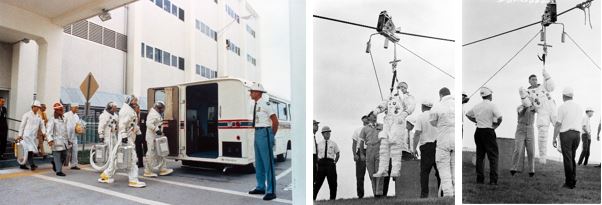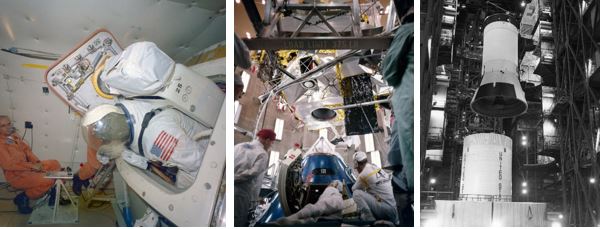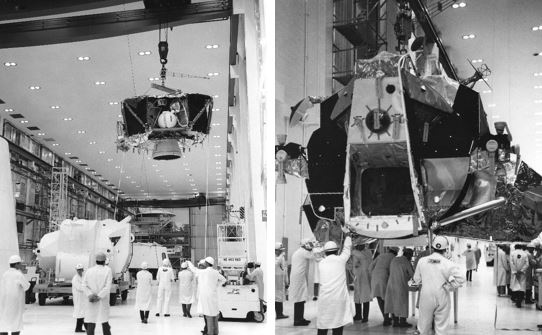As Apollo 7 completed its highly successful engineering test mission, preparations intensified for the next flight, Apollo 8, the first to use the Saturn V rocket to send astronauts into space in December 1968. With two months to go before their historic launch, the Apollo 8 crew busied themselves with egress training both at the launch pad and at sea, as well as spending time in mission simulators. Preparations for the following two missions, Apollo 9 and 10, were also well underway. Apollo 9 was planned as the first crewed flight of the Lunar Module (LM) in Earth orbit in February 1969 and Apollo 10 most likely as a lunar orbit flight three months later. With the Apollo Program now flying astronauts in space and preparations and training underway for several missions, the goal of landing a man on the Moon before the end of the decade seemed within reach.
October 23, 1968, was a busy day at the Kennedy Space Center (KSC). The Apollo 7 crew arrived back at KSC one day after returning to Earth from their highly-successful 11-day mission to thoroughly test the Apollo spacecraft in Earth orbit. Wearing their pressure suits, Apollo 8 astronauts participated in emergency egress training and practiced slide wire evacuation techniques at Launch Complex 39A, where engineers were testing the Saturn V rocket and Apollo spacecraft since the rollout October 9. The prime crew of Frank Borman, James A. Lovell, and William A. Anders, as well as the backup crew of Neil A. Armstrong, Edwin E. “Buzz” Aldrin, and Fred W. Haise, took part in the egress training. For the slide wire evacuation training, the astronauts only practiced the final portion including dismounting, and not the full test from the 350-foot level of the launch tower.
Two days later, Borman, Lovell, and Anders were in the Gulf of Mexico near Galveston, Texas, conducting water egress training using a boilerplate Apollo spacecraft. The Motor Vessel M/V Retriever supported the activity, with sailors lowering the mockup Command Module (CM) with the crew inside into the water in a nose-down position. Flotation bags inflated to right the spacecraft to a nose-up position. The astronauts then exited the capsule onto life rafts and recovery personnel hoisted them aboard a helicopter. The next day, Armstrong, Aldrin, and Haise repeated the test.
Senior NASA managers were still evaluating the actual flight objectives for Apollo 8. On October 28, Associate Administrator for Manned Space Flight George E. Mueller and Apollo Program Director Samuel C. Phillips announced that in addition to the baseline Earth orbit mission using a Saturn V, NASA was assessing three alternative possibilities – an Earth orbital flight deeper into space, a circumlunar fly-by, and a lunar orbit mission. A decision to be announced in mid-November would follow a detailed analysis of the recently completed Apollo 7 mission, certification of changes made to the Saturn V following the Pogo problems encountered during Apollo 6, completion of flight computer programs for deep space and lunar missions, and rehearsal through computer simulations of the Mission Control ground systems. Thomas O. Paine, NASA Acting Administrator added, “The final decision on whether to send Apollo 8 around the moon will be made after a thorough assessment of the total risks involved and the total gains to be realized in this next step toward a manned lunar landing.”
Preparations for Apollo 9 included training for the first Extravehicular Activity (EVA) or spacewalk of the Apollo program. According to the mission plan, while the LM and CM were docked crewmembers in both spacecraft were to open their hatches. One astronaut would transfer via EVA from the LM to the CM using handrails for guidance and enter the CM in a test of an emergency rescue capability. The training took place aboard a KC-135 aircraft from Patrick Air Force Base in Florida. By flying repeated parabolic trajectories, the aircraft could simulate 20-30 seconds of weightlessness at a time, during which the astronauts wearing space suits practiced entering and exiting a mockup of the CM. Backup crewmembers Richard F. Gordon and Alan L. Bean completed the training on October 9 followed by David R. Scott and Russell L. Schweickart of the prime crew the next day.
Grumman Aircraft Engineering Corporation in Bethpage, New York, manufacturer of the LM, delivered the one for Apollo 9 to KSC in June 1968 where engineers were thoroughly checking out its systems. North American Rockwell in Downey, California, manufacturer of the Command and Service Modules, delivered them to KSC in early October. At the end that month, technicians in the Manned Spacecraft and Operations Building (MSOB) conducted a docking test of the Apollo 9 LM and CM to verify the interfaces between the two vehicles. Elsewhere at KSC, in the Vehicle Assembly Building workers stacked the three stages of the Saturn V rocket for Apollo 9 during the first week of October.
In preparation for Apollo 10, Grumman delivered the LM for that mission to KSC. The descent stage arrived October 11 followed by the ascent stage five days later. Technicians in the MSOB mated the two stages and installed the assembled vehicle into a vacuum chamber on November 2 to begin a series of tests.

































